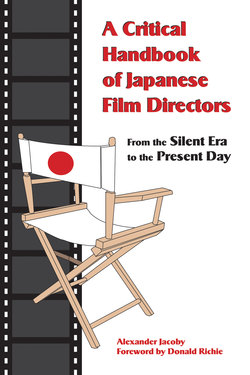Читать книгу A Critical Handbook of Japanese Film Directors - Alexander Jacoby - Страница 28
На сайте Литреса книга снята с продажи.
HAYASHI Kaizō
Оглавление(b. July 15, 1957)
林海象
Hayashi is the movie brat of modern Japanese directors: his films, often shot nostalgically in black and white, have essayed postmodern reworkings of classical genres. Before directing, he worked with Shūji Terayama’s Tenjōsajiki theatrical troupe, a background faintly visible in the carnivalesque elements and surreal touches of To Sleep So as to Dream (Yume miru yōni nemuritai, 1986) and Circus Boys (Nijūseiki shōnen dokuhon, 1989). Both these early films showed definite promise. The former was a film buff’s joke: a silent film, shot in lustrous monochrome, in which two private detectives discover a kidnapping victim trapped in a fragment of an old chanbara. Though something of an exercise, the film played wittily with the way in which a star’s filmed image ultimately supplants the real, mortal self. More emotionally affecting was Circus Boys, a bittersweet account of the different paths taken in life by two brothers brought up in a traveling circus. Here the black and white visual poetry spoke for a human rather than an aesthetic nostalgia, creating a low-key poignancy in its sense of the difficulties and disappointments of adult life compared to the simplicity of childhood dreams.
In The Most Terrible Time in My Life (Waga jinsei saiaku no toki, 1994), Hayashi again opted for black and white, turning modern Yokohama into a moody backdrop to a marvelously well-judged pastiche of film noir. Though admittedly a little too reminiscent of a minor Truffaut twenty-five years too late, it was given human depth by Masatoshi Nagase’s superb performance as inept private eye Maiku Hama, and the ending was genuinely cathartic. Hayashi made two more films featuring the same character, but these, relatively blandly shot in color, suffered from the diminishing returns characteristic of most sequels. Nevertheless, Hayashi later revived the character for a television series in which each episode was directed by a filmmaker of note; Shinji Aoyama’s contribution, The Forest with No Name (Shiritsu tantei Hama Maiku: Namae no nai mori, 2002), later received a cinema release in its own right.
Hayashi’s attempts to parody other genres have proved less successful. Zipang (1990), was a wild jidai-geki set in a stylized medieval Japan vaguely inspired by Marco Polo’s misapprehensions; spectacular art direction did not compensate for its overall vacuity. Even sillier was Cat’s Eye (1997), a paper-thin, crudely characterized and clumsily plotted adaptation of a manga about a trio of female cat burglars. Nevertheless, Hayashi has remained willing to experiment with new approaches, even attempting a hyperrealist style in The Breath (Umihōzuki, 1996), which used only ambient light to film a story about a washed-up detective investigating a disappearance in Taiwan. With his first American film Lost Angeles (2000), Hayashi brought his penchant for pastiche to a realist genre, producing a spoof documentary about the experiences of a Japanese rock band in the United States. However, this was rather poorly received, and Hayashi has not since realized a theatrical feature. Even his best films clearly owed much to his collaborators, particularly art director Takeo Kimura and cinematographer Yūichi Nagata (significantly, his monochrome films have proved much better than his color ones). But the directorial flair and wit of Circus Boys and The Most Terrible Time in My Life should not be discounted.
1986 Yume miru yōni nemuritai / To Sleep So as to Dream
1988 Idea (short)
1989 Nijūseiki shōnen dokuhon / Circus Boys / The Boy’s Own Book of the 20th Century (lit.)
1990 Zipang / Zipang / The Legend of Zipang
1991 Figaro Stories (co-director)
1994 Waga jinsei saiaku no toki / The Most Terrible Time in My Life
1995 Harukana jidai no kaidan o / Stairway to the Distant Past
1996 Wana / The Trap
Umihōzuki / The Breath
1997 Romance (short)
Cat’s Eye
Chinnanē / Born to be Baby (short)
1998 Otome no inori / A Maiden’s Prayer (short; unreleased)
2000 Lost Angeles
